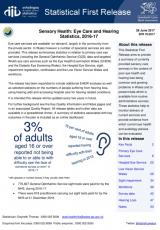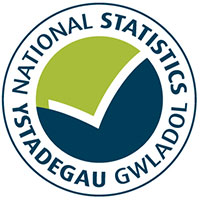The report aims to provide a summary of currently provided sensory care services in the context of poor eye health and hearing loss for April 2016 to March 2017.
This is not the latest release in the series: Sensory health (eye care and hearing statistics)
Series information:
Sight loss
- The National Survey for Wales for 2016-17 asked if respondents’ eyesight was good enough to see the face of someone across a room, with glasses or contact lenses if they usually wear them. 3% of adults aged 16 or over responded that either they could not or with difficulty.
Primary eye care services
- During 2016-17, 776,827 General Ophthalmic Service sight tests were paid for by the NHS, a 1.0% increase on the previous year.
- 150,324 examinations were carried out under Eye Health Examinations Wales during the same year.
- Of the 139,264 patients screened (with results reported) by the Diabetic Eye Screening Wales Service in 2016-17, 28.2% were found to have some degree of diabetic retinopathy (a small number were ungradeable).
Hospital eye services
- There were 322,139 attendances to ophthalmology outpatient appointments in Welsh hospitals in 2015-16.
- Health Boards received 91,846 referrals for ophthalmology in 2016-17, of which 31,824 were from GPs.
Rehabilitation
Low Vision Service Wales
- 8,792 assessments were carried out by the Low Vision Service Wales.
People newly certified and/or registered as severely sight impaired and sight impaired
- At 31 March 2016, over 16,000 people were registered with a visual impairment, of whom around half were registered as severely sight impaired and half as sight impaired.
- 1,388 people were newly certified as sight impaired in 2015-16; over 55% of these were aged 80 years or over.
Workforce
- There were 819 practitioners carrying out sight tests paid for by the NHS at 31 December 2016, 1 more than in the previous year and a 21.7% increase since December 2006.
- At 30 September 2016 there were 137.7 whole time equivalent ophthalmology doctors directly employed by the NHS in Wales.
Hearing
- Welsh Health Survey recorded that 16% of adults reported having difficulty with their hearing in 2015.
- At 31 March 2017, 390 patients had been waiting for a hearing aid for more than the target 14 weeks.
- At 30 September 2016 there were 133.6 whole time equivalent otolaryngology doctors directly employed by the NHS in Wales.
Reports

Sensory health: eye care and hearing statistics, April 2016 to March 2017 , file type: PDF, file size: 2 MB
PDF
2 MB
If you need a more accessible version of this document please email digital@gov.wales. Please tell us the format you need. If you use assistive technology please tell us what this is.
Data
Datasets and interactive tools
Sensory health: eye care and hearing statistics, April 2016 to March 2017: tables , file type: ODS, file size: 267 KB
ODS
267 KB
If you need a more accessible version of this document please email digital@gov.wales. Please tell us the format you need. If you use assistive technology please tell us what this is.
Sensory health: eye care and hearing statistics, April 2016 to March 2017: dashboard , file type: XLSX, file size: 921 KB
XLSX
921 KB
If you need a more accessible version of this document please email digital@gov.wales. Please tell us the format you need. If you use assistive technology please tell us what this is.
Contact
Stephanie Harries
Telephone: 0300 025 6186
Email: stats.healthinfo@gov.wales
Rydym yn croesawu galwadau a gohebiaeth yn Gymraeg / We welcome calls and correspondence in Welsh.

